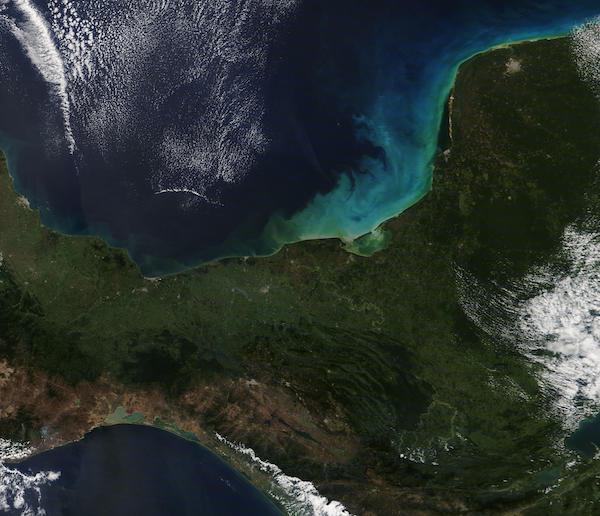Images
February 6, 2021 - Color in the Bay of Campeche
Tweet
Bright jewel-toned plumes of color graced the near-shore waters of the Bay of Campeche in early February 2021. The Moderate Resolution Imaging Spectroradiometer (MODIS) on board NASA’s Terra satellite acquired a true-color image of the scene on February 4.
The color likely comes primarily from sediment, which scatters light and changes the color of water in which it floats. Sediment may be washed into the water or may be stirred up from the bottom. Some color may also be from phytoplankton—microscopic plant-like organisms that live in these waters year-round but, when conditions are right, may reproduce explosively to create a large bloom of color that can be easily seen from space.
Close to the shoreline and in the large tidal lagoon (the Laguna de Términos) the water appears a muddy tan or greenish-tan, indicating that mud-colored sediment has been washed into the Bay and remains close to the surface. As sediment disperses or sinks, the reflectivity changes and color changes to green and then black.
When sediment is stirred from the bottom—usually by wave action or by current flow—the resultant visible color depends on the type of suspended material. Milky-blue swirls indicate the presence of calcium carbonate in the sediment. The origin of calcium carbonate may be from shell-building marine life, such as coral, or from limestone, or even from coccolithophores, which are a type of phytoplankton that have calcite plates. The milky-blue swirls in this image are likely from sediment stirred from the bottom by a combination of rains, strong tides, and heightened flow through the Laguna de Términos. Several rivers flow from Mexico’s Yucatan Peninsula into the Laguna de Términos, carrying heavy sediment. The Bay of Campeche, which is part of the Gulf of Mexico, typically carries colorful sediment when seen from space.
Image Facts
Satellite:
Terra
Date Acquired: 2/4/2021
Resolutions:
1km (117.9 KB), 500m (407.3 KB), 250m (1.2 MB)
Bands Used: 1,4,3
Image Credit:
MODIS Land Rapid Response Team, NASA GSFC
Tweet
Bright jewel-toned plumes of color graced the near-shore waters of the Bay of Campeche in early February 2021. The Moderate Resolution Imaging Spectroradiometer (MODIS) on board NASA’s Terra satellite acquired a true-color image of the scene on February 4.
The color likely comes primarily from sediment, which scatters light and changes the color of water in which it floats. Sediment may be washed into the water or may be stirred up from the bottom. Some color may also be from phytoplankton—microscopic plant-like organisms that live in these waters year-round but, when conditions are right, may reproduce explosively to create a large bloom of color that can be easily seen from space.
Close to the shoreline and in the large tidal lagoon (the Laguna de Términos) the water appears a muddy tan or greenish-tan, indicating that mud-colored sediment has been washed into the Bay and remains close to the surface. As sediment disperses or sinks, the reflectivity changes and color changes to green and then black.
When sediment is stirred from the bottom—usually by wave action or by current flow—the resultant visible color depends on the type of suspended material. Milky-blue swirls indicate the presence of calcium carbonate in the sediment. The origin of calcium carbonate may be from shell-building marine life, such as coral, or from limestone, or even from coccolithophores, which are a type of phytoplankton that have calcite plates. The milky-blue swirls in this image are likely from sediment stirred from the bottom by a combination of rains, strong tides, and heightened flow through the Laguna de Términos. Several rivers flow from Mexico’s Yucatan Peninsula into the Laguna de Términos, carrying heavy sediment. The Bay of Campeche, which is part of the Gulf of Mexico, typically carries colorful sediment when seen from space.
Image Facts
Satellite:
Terra
Date Acquired: 2/4/2021
Resolutions:
1km (117.9 KB), 500m (407.3 KB), 250m (1.2 MB)
Bands Used: 1,4,3
Image Credit:
MODIS Land Rapid Response Team, NASA GSFC




